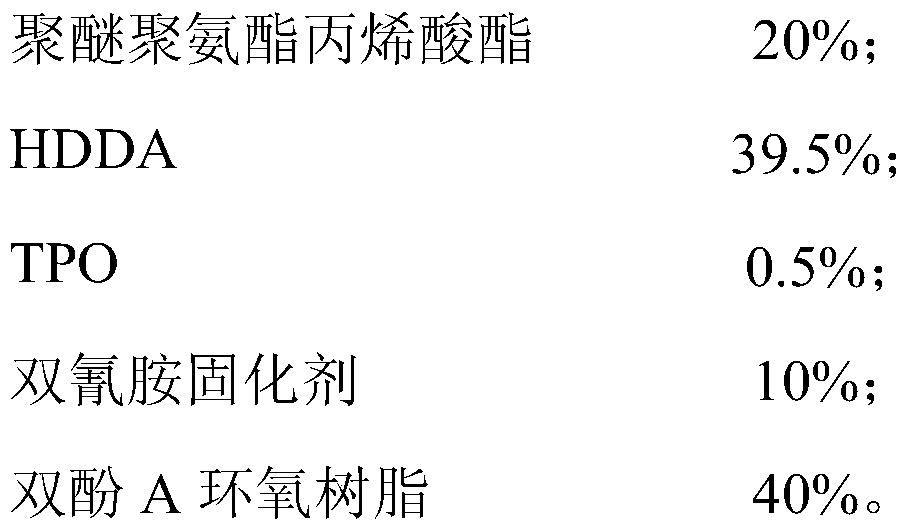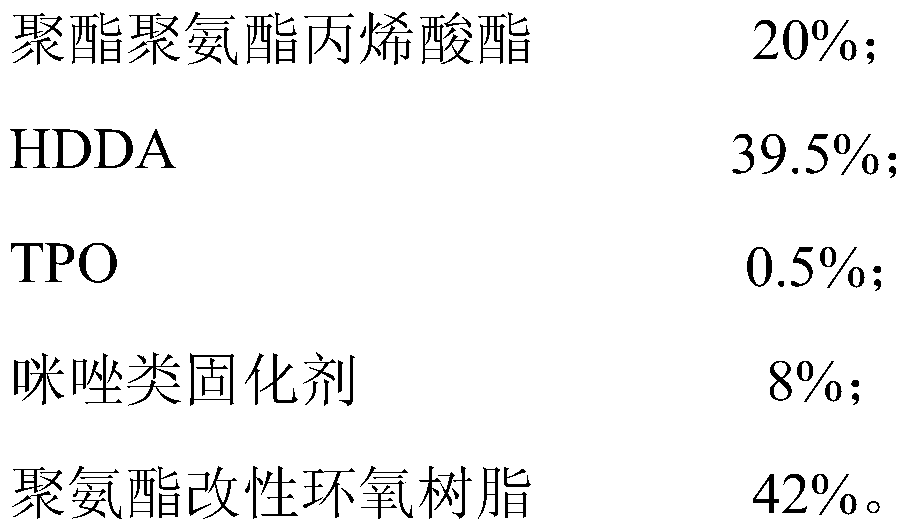Photo-thermal double curing 3D printing method and product thereof
A 3D printing and dual curing technology, applied in the field of 3D printing, can solve the problems of easy brittleness and loss of toughness of products, achieve good toughness, improve elongation at break, and broaden the scope of application.
- Summary
- Abstract
- Description
- Claims
- Application Information
AI Technical Summary
Problems solved by technology
Method used
Image
Examples
Embodiment 1
[0025] (1) Preparation of polyurethane polyacrylate: mix 1mol PPG-1000 with DBT accounting for 0.5% by weight of PPG-1000, add dropwise to 2mol HDI, react at 60°C for 1h, then add 2mol HEA, react at 60°C for 3h, Obtain polyether urethane acrylate;
[0026] (2) Light-thermal dual curing 3D printing: mix the polyether urethane acrylate obtained in step (1) with HDDA and TPO according to the following mass percentages, and use a light-curing printer for 3D printing to obtain a photopolymer. Test The glass transition temperature of the photopolymer is -18°C, which is lower than room temperature; then according to the following mass percentage, mix polyether urethane acrylate, HDDA, TPO, dicyandiamide curing agent and bisphenol A epoxy resin and then photocure and print , and then heated to 160 ° C for 6 hours to obtain 3D printed products; the dicyandiamide curing agent is produced by Guangzhou Xinxi Metallurgical Chemical Co., Ltd., the brand name is SH-300, and the bisphenol A e...
Embodiment 2
[0029] (1) Preparation of polyurethane polyacrylate: mix 1mol PCDL-1000 with DBT accounting for 0.5% by weight of PCDL-1000, add dropwise to 2mol HDI, react at 60°C for 1h, then add 2mol HEA, react at 60°C for 3h, Obtain polyester urethane acrylate;
[0030] (2) Photo-thermal dual curing 3D printing: mix the polyester urethane acrylate obtained in step (1) with HDDA and TPO according to the following mass percentage, and use a light-curing printer to perform 3D printing to obtain a polymer, and test the polymer. The glass transition temperature is -11°C, which is lower than room temperature; according to the following mass percentage, mix polyester urethane acrylate, HDDA, TPO, imidazole curing agent and polyurethane modified epoxy resin evenly, light-cure and print, and heat to After curing at 110°C for 6 hours, the 3D printed product was obtained; the imidazole curing agent was produced by Guangzhou Xinxi Metallurgical Chemical Co., Ltd., the brand name is SH-A80, and the po...
Embodiment 3
[0033] (1) Preparation of polyurethane polyacrylate: mix 1mol PCDL-1000 with DBT accounting for 0.5% by weight of PCDL-1000, add dropwise to 2mol HDI, react at 60°C for 1h, then add 2mol HEA, react at 60°C for 3h, Obtain polyester urethane acrylate;
[0034](2) Photo-thermal dual curing 3D printing: the polyester urethane acrylate obtained in step (1) is mixed with IBOA and TPO according to the following mass percentage, and 3D printing is performed using a light-curing printer to obtain a polymer, and the polymer is tested. The glass transition temperature is 6°C, which is lower than room temperature; according to the following mass percentage, mix polyester urethane acrylate, IBOA, TPO, ammonium blocked Lewis acid salt and alicyclic epoxy resin evenly, light-cure 3D printing, and then heat After curing at 100°C for 6 hours, 3D printed products were obtained; the ammonium-blocked Lewis acid salt was purchased from Shenzhen Kaiji Applied Materials Co., Ltd., trade name Vicbase...
PUM
| Property | Measurement | Unit |
|---|---|---|
| glass transition temperature | aaaaa | aaaaa |
| glass transition temperature | aaaaa | aaaaa |
| glass transition temperature | aaaaa | aaaaa |
Abstract
Description
Claims
Application Information
 Login to View More
Login to View More - R&D Engineer
- R&D Manager
- IP Professional
- Industry Leading Data Capabilities
- Powerful AI technology
- Patent DNA Extraction
Browse by: Latest US Patents, China's latest patents, Technical Efficacy Thesaurus, Application Domain, Technology Topic, Popular Technical Reports.
© 2024 PatSnap. All rights reserved.Legal|Privacy policy|Modern Slavery Act Transparency Statement|Sitemap|About US| Contact US: help@patsnap.com










